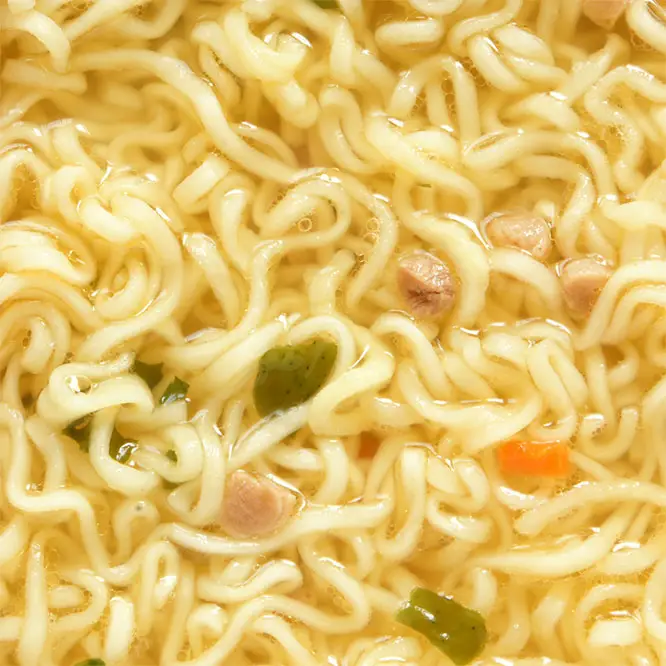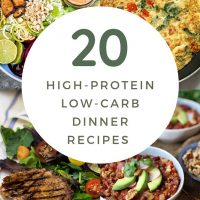Recently updated on November 2nd, 2023 at 09:26 am

Pot noodles were developed in 1958 by Momofuku Ando. They consist of dehydrated noodles with dried vegetables and flavourings and are usually advertised as a quick and easy-to-prepare snack.
But are pot noodles considered a healthy meal? We’ve investigated the different types of instant noodle to discover if they are good or bad for you.
What ingredients are in Pot Noodles?
Here are some of the most common ingredients found in noodle pots:
- Noodles (wheat or rice): The dehydrated noodles are mainly produced from wheat, although some noodle pots—such as the Itsu and ASDA brands—use a rice noodle.
- Palm oil: This is often used as an ingredient in processed foods. It is high in saturated fats but does include monosaturated fats as well. Due to the way palm oil is harvested, it has also been negatively linked to environmental concerns.
- Salt: The UK Government recommends adults should consume no more than 6g salt per day. Depending on the brand, instant noodles contain an average of 1.99g of salt per pot, which is a third of the recommended daily RDI for salt.
- Maltodextrin: This is a thickening agent used in a variety of processed foods which also acts as a preservative to prolong the shelf-life of products. It is high on the glycaemic index (GI), meaning that it can cause a spike in your blood sugar. This is something to be aware of—especially if you have diabetes.
- Sugar: Added sugar can be found in many different types of food including pot noodles. While it makes the food taste better, it’s not good for your health as it just adds extra calories and no nutrients to the food you are eating.
- Dried vegetables: Depending on the flavour, noodle pots can contain dried peas, sweetcorn, mushrooms, carrots and onion.
- Flavour enhancers: Pot noodles are flavoured with a variety of herbs such as chive, sage, cumin and cayenne pepper. Some also contain monosodium glutamate (MSG) which could prove harmful in large quantities. While further studies are needed, MSG has been linked to obesity.
Here is a full breakdown of the ingredients in the pot noodle brands we have researched:
| BRAND | INGREDIENTS |
| Pot Noodle Bombay Bad Boy | Noodle mix (96%): Dried noodles (65%) [WHEAT flour (contains calcium carbonate, iron, niacin, thiamin), palm oil, salt, firming agents (potassium carbonate, sodium carbonates)], maltodextrin, WHEAT flour, curry (coriander, cumin, turmeric, pepper, aniseed, cinnamon, fennel seed, ginger, lovage root, cayenne pepper, allspice), yeast extract, garlic†, sweetcorn, peas†, sugar, salt, onion powder†, palm fat, BARLEY malt extract, potato starch, soy sauce (SOYBEANS, WHEAT), flavourings, acid (citric acid), paprika†. Sauce Sachet (4%): Chilli sauce (water, spirit vinegar, modified corn starch, salt, cumin, cayenne pepper, flavourings). †From sustainable agriculture May contain milk, egg, celery and mustard |
| Pot Noodle Chicken & Mushroom | Noodle mix (96%): Dried noodles (69%) [WHEAT flour, palm oil, salt, firming agents (potassium carbonate, sodium carbonates)], maltodextrin, WHEAT flour, sweetcorn, potassium chloride, flavour enhancers (monosodium glutamate, disodium inosinate, disodium guanylate), flavourings (contain MILK), sugar, skimmed MILK powder, palm fat, salt, onion powder†, yeast powder (contain WHEAT, BARLEY), mushrooms (0.4%), herbs (chives†, sage), potato starch, mushroom juice concentrate†, acid (citric acid). Sauce sachet (4%): Soy sauce [water, soy sauce (SOYBEANS, WHEAT), salt, molasses, sugar, acid (acetic acid)]. †From sustainable agriculture May contain egg, celery and mustard |
| Pot Noodle Original Curry | Noodle mix (96%): Dried noodles (64%) [WHEAT flour (contains calcium carbonate, iron, niacin, thiamin), palm oil, salt, firming agents (potassium carbonate, sodium carbonates)], maltodextrin, WHEAT flour, sugar, glucose syrup, carrots†, peas†, acidity regulator (sodium acetates), onion powder†, palm fat, flavour enhancer (monosodium glutamate), curry (0.5%) (cumin, coriander, turmeric, fenugreek seed, bay leaves, cloves, black pepper, cinnamon, chilli, fennel seed), flavourings, salt, yeast extract, potato starch, potassium chloride, garlic†, cheese powder (MILK). Sauce Sachet (4%): Mango sauce [mango puree (88%) (mango, sugar, salt, acid (acetic acid), spices), water, spirit vinegar, modified corn starch, cayenne pepper]. †From sustainable agriculture May contain egg, soy, celery and mustard |
| Batchelor’s Super Noodle Pot Bbq Beef | Noodles (80%) (Wheat Flour, Palm Oil, Potato Starch, Acidity Regulators (Potassium Lactate, Citric Acid), Salt, Flavour Enhancer (Monosodium Glutamate), Colour (Carotenes), Antioxidant (Tocopherol-Rich Extract), Stabiliser (Potassium Carbonate), Flour Treatment Agent (Sodium Carbonate)), Maltodextrin, Wheat Flour, Maize Starch, Flavourings (contain Milk), Dried Peas (1%), Yeast Extract, Dried Carrot (0.5%), Flavour Enhancers (Monosodium Glutamate, Disodium 5′-ribonucleotides), Onion Powder, Milk Mineral Concentrate, Salt, Colours (Plain Caramel, Paprika Extract), Thickener (Guar Gum), Thyme Extract, Acid (Citric Acid), Black Pepper Extract, Sugar, Parsley, Smoke Flavourings |
| Itsu Katsu Noodle Cup
(NO MSG) |
Rice Noodles (63%): Rice (85%), Modified Tapioca Starch, Sugar, Salt, Stabiliser: Guar Gum, Broth Paste (36%): Soybean Paste (Water, Soya Beans, Rice, Salt), Sugar, Seasoned Bonito Extract (Bonito Extract [Fish] Water, Tamari Soy Sauce (Soya Beans, Salt, Alcohol), Rice Bran Oil, Alcohol, Yeast Extract Powder, Curry Powder (contains Mustard), Spice Mix, Salt, Paprika Powder, Garlic Powder, Ginger Powder, Coriander, Dried Vegetable Sachet: Spring Onion |
| Nissin Soba Classic Instant Noodles | Noodles 72, 3% [Wheat Flour, Palm Oil, Salt, Flavour Enhancer E621 (MSG), Flour Treatment Agents (E500, E451), Antioxidant E306, Acidity Regulator: Citric Acid], Seasoning Sauce 19, 9% [Sugar, Water, Rapeseed Oil, Soy Sauce (Water, Soybean, Salt, Wheat), Flavour Enhancers (E621, E635), Colour E150c, Dextrose, Molasses, Vinegar, Salt, Spices, Hydrolysed Vegetable Protein, Tomato Powder, Acidity Regulator: Citric Acid, Flavouring, Cabbage, Chicken Meat Cube |
| Naked Noodle Singapore Curry (NO MSG) | Dried Egg Noodles [Soft Wheat, Durum Wheat Semolina, Egg, Salt, Acidity Regulator (Potassium Carbonate)], Potato Starch, Maltodextrin, Sugar, Natural Flavourings, Carrot (2.3%), Garlic Powder, Curry Powder [Coriander, Turmeric, Salt, Pimento, Ginger, Fenugreek, Garlic Powder, Black Pepper, Cumin, Red Pepper, Bay], Spring Onion, Dried Onion, Onion Powder, Chinese Five Spice [Salt, Star Anise, Sugar, Onion Powder, Garlic Powder, Black Pepper, Cinnamon, Clove, Fennel Seed, Ginger], Mushroom Extract Powder, Chilli Powder, Dried Coriander, Ground Turmeric, Palm Oil, Colour (Curcumin) |
| ASDA Free From Singapore Curry Rice Noodle Pot | Dried Rice Noodles (67%) [Rice Flour, Tapioca Starch], Maltodextrin, Potato Starch, Dried Carrots (2.7%), Sugar, Yeast Extract, Curry Powder [Coriander, Turmeric, Salt, Allspice, Ginger, Fenugreek, Garlic Powder, Ground Black Pepper, Cumin, Red Pepper Powder, Bay], Garlic Powder, Dried Spring Onions, Onion Powder, Dried Onions, Flavourings, Salt, Chinese 5 Spice [Salt, Star Anise, Onion Powder, Sugar, Cinnamon, Black Pepper, Ginger, Fennel, Cloves, Garlic Powder], Mushroom Extract Powder, Chilli Powder, Dried Coriander, Ground Turmeric, Coconut Oil, Rapeseed Oil |
Do pot noodles have any nutritional value?
As with any food where you ‘just add hot water,’ the nutritional values can be easily manipulated. In this type of product, the key numbers are not the per 100g figures but the ‘per pot’ rehydrated figures which give you a true picture of what you are consuming.
We took the UK’s most popular instant noodle—Pot Noodle Chicken and Mushroom—and took an in-depth look at its nutritional values to compare the per 100g and per pot figures:
| Typical values as prepared | Per 100g | Per Pot |
| ENERGY | 141 kcal | 430 kcal |
| FAT | 5.7g | 17g |
| FAT (OF WHICH SATURATES | 2.8g | 8.5g |
| CARBOHYDRATES | 19g | 58g |
| – OF WHICH SUGARS | 1.1g | 3.4g |
| FIBRE | 1.2g | 3.7g |
| PROTEIN | 3.2g | 9.8g |
| SALT | 0.63g | 1.9g |
Protein
The NHS website suggests an RDI of 50g protein for adults, but not all protein is good for you. Pot noodle protein is loaded with sodium and additives which are not healthy. The average protein value per pot is around 10g. We recommend sourcing your protein from healthier food, such as chicken breasts, broccoli or almonds.
Sugar
As well as having a high salt content, pot noodles also contain added sugar, for example, the Chicken and Mushroom Pot Noodle flavour contains almost 1 teaspoon per pot. We should all be trying to reduce our sugar intake—it’s one of the leading causes of obesity and dental issues in the UK.
Fibre
Noodle pots contain very little fibre. The recommended daily fibre intake for adults is 30g per day, but most adults do not consume enough fibre (the daily average intake for a UK adult is just 17.2g for women and 20.1g for men). A diet that is low in fibre is linked to constipation and certain types of diseases including bowel cancer.
Vitamins and minerals
So far, pot noodles have not fared well in our investigation into their nutritional values, and the news does not get any better when we look at vitamins and minerals. In the Pot Noodle brand, there are no mineral or vitamins at all.
Are pot noodles high in fat?
The fat content of a pot noodle is generally high—roughly 17g per prepared pot—of which 8.5g is saturated fat.
The NHS states that the average man should not consume more than 30g of saturated fat a day and the average woman should not eat more than 20g a day. This means that most pot noodles are really high in saturated fat.
Consuming too much saturated fat can raise your cholesterol and increase your risk of heart disease. However, if you decide to eat noodle pots, we suggest opting for either the Itsu Katsu Noodle Cup with 0.9g fat, or the ASDA Free From Singapore Curry Rice Noodle Pot with 1.5g fat per portion.
Salt in pot noodles
All the pot noodle brands we reviewed have high levels of salt.
Consuming too much salt can cause high blood pressure, which may increase your risk of heart disease or stroke. The producers of Pot Noodle reduced the amount of salt in their products by 50% in 2007, but even with the reduction, the salt levels are still high.
Calories in pot noodles
Our findings have shown that pot noodles are calorific, with 430 kcal in a prepared pot of Chicken and Mushroom Pot Noodle. This is almost a quarter of the recommended 2000 kcal of the average adult.
Some varieties contain fewer calories (these are generally the ones that list rice noodles as the main ingredient) such as the Itsu Katsu Noodle Cup and the ASDA Free From Singapore Curry Rice Noodle Pot.
Here is a detailed breakdown of the nutritional values of noodle pots per 100g. Remember to keep in mind that the per pot values are much higher:
| BRAND/SUPERMARKET | PROTEIN | SUGAR | FAT | FIBRE | SALT | CALORIES |
| Pot Noodle Bombay Bad Boy | 3.2 g | 0.9 g | 5.5 g | 1.3 g | 0.4 g | 143 kcal |
| Pot Noodle Chicken & Mushroom | 3.2 g | 1.1 g | 5.7 g | 1.2 g | 0.63 g | 141 kcal |
| Pot Noodle Original Curry | 2.8 g | 2 g | 5.4 g | 1.2 g | 0.48 g | 145 kcal |
| Batchelors Super Noodle Pot Bbq Beef | 2.5g | 1.4g | 5.7g | 0.8g | 0.56g | 134 kcal |
| Itsu Katsu Noodle Cup
(NO MSG) |
0.3g | 1.4g | 0.3g | 0.9g | 0.73g | 61 kcal |
| Nissin Soba Classic Instant Noodles | 5.3 g | 4.7 g | 9.8 g | Not disclosed | 2.0 g | 219 kcal |
| Naked Noodle Singapore Curry (NO MSG) | 3.2g | 2.0g | 0.8g | 0.8g | 0.53g | 83kcal |
| ASDA Free From Singapore Curry Rice Noodle Pot | 1.5g | 0.9g | <0.5g | 0.8g | 0.59g | 76kcal |
Are pot noodles good for weight loss?
Despite a high-calorie count, pot noodles are not very filling, so if you are trying to lose weight, they are not a healthy choice as you’ll soon feel hungry again after eating one.
They also contain maltodextrin, which is a carbohydrate and a sweetener with no nutritional value, adding to the empty calories you’ll consume.
Healthy alternatives to pot noodles
While many people opt for a pot noodle as it provides a time-saving instant snack, there are healthier alternatives that can be prepared just as quickly.
Try Uncle Ben’s Brown Wholegrain Microwavable Rice which is low in fat, salt, sugar and saturates. Add a portion of tinned salmon or mackerel for a protein hit that will keep you feeling full for longer.
This organic pasta pot is a healthier ‘just add water’ snack which is ready to eat in four minutes. It’s packed with vegetables and has no added salt or sugar. A 45g pot contains just 50 kcal, making it a sensible alternative to pot noodle if you are trying to reduce your weight.
Healthier pot noodle choices
If you’re looking for a pot noodle that is healthy than the mainstream brands, Mr Lees Coconut Chicken Laska Noodles is a good choice. This snack contains no palm oil, is lower sugar and gluten-free and provides a good source of protein. It also has a spicy flavour, so it’s tasty too!
Homemade alternatives to pot noodles
This homemade pot noodle recipe is packed with nutritious and tasty ingredients such as egg noodles, peppers, carrots, Pak Choi, onions, and sugar snap peas. The noodle jars can be prepared and kept in the fridge for up to three days and are filling enough to stop you snacking in the afternoon. If you’re on the Slimming World plan, this recipe is also Syn free.
Final thoughts – are pot noodles healthy?
We wouldn’t recommend pot noodles as part of a balanced diet. Pot noodles are also a type of MREs. The nutritional values are almost non-existent and they are high in salt, sugar and fat.
While we admit they are quick to prepare if you are in a hurry, we’ve detailed some just-as-speedy alternatives that provide more of the nutrients your body needs to stay healthy.
Author Bio
Kerry Garner has an interest in nutrition and is always on the look-out for new, healthy and exciting snacks for her son’s packed lunch to ensure he gets a balanced diet that’s not boring. She is a keen home-cook and loves nothing more than experimenting in the kitchen and inventing nutritious, yet tasty meals for her family to enjoy.




1 Comment
I cant get enough of pot noodles sometimes. Super easy and quick to make, and also tasty. I eat the Maggi and Bachelor’s noodles quite a bit, which I know isn’t the best now reading this. I just like them a lot 😛